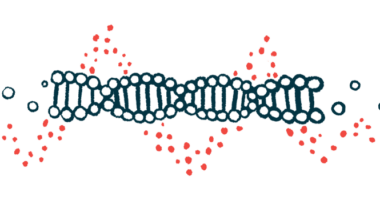Mutations linked to vascular EDS alter ECM properties: Study
Scaffold's mechanical properties could serve as a prognostic indicator for disease

Mutations that cause vascular Ehlers-Danlos syndrome (vEDS) result in less collagen production and altered properties of the extracellular matrix (ECM), the molecular scaffold that supports cells and gives shape to tissues, a study shows.
Because altered ECM properties seemed to be associated with more severe disease, they may serve as an outcome indicator with vEDS, the researchers suggested in “Patient-derived extracellular matrix demonstrates role of COL3A1 in blood vessel mechanics,” which was published in Acta Biomaterialia.
Most vEDS cases are caused by mutations in the COL3A1 gene, which provides instructions for making type III collagen. Collagens are proteins that strengthen and support skin, tissues, and organs.
In addition to easily bruised, fragile skin, as seen in other types of EDS, vEDS-associated mutations can weaken arteries, increasing the risk of ruptures and life-threatening bleeding.
Type III collagen is a major component of the ECM. However, how defects in type III collagen lead to vEDS symptoms is unclear, leading researchers at the University of North Carolina to develop a method to generate ECM directly from connective tissue cells, called fibroblasts, from three vEDS patients.
Each patient had a different COL3A1 mutation — COL3A1-G939D, COL3A1-766delA, and COL3A1-IVS40-1G>A. Patients harboring the COL3A1-G939D mutation are at a significantly higher risk for aneurysms — abnormal bulges in blood vessel walls — and have more severe disease.
Differences in fibroblasts, ECM properties
Fibroblasts from the patients showed decreased production of the COL3A1 protein and the cells were significantly larger than healthy fibroblasts and displayed variable shapes.
Fibroblasts carrying the COL3A1-G939D mutation deposited ECM layers of similar thickness to healthy cells, while those carrying either COL3A1-766delA or COL3A1-IVS40-1G>A mutations deposited significantly thinner layers.
ECM from fibroblasts harboring COL3A1-766delA and COL3A1-IVS40-1G>A mutations had significantly lower collagen content than the COL3A1-G939D mutation. Regardless, the diameter of collagen fibers was markedly smaller from all vEDS donors than from healthy controls.
The ECM protein content from vEDS donor fibroblasts differed significantly from ECM from healthy donors, including increases in collagen subtypes and other proteins related to ECM’s structural integrity.
ECM is secreted and deposited by fibroblasts, which eventually contract to a smaller size. A faster contraction time correlated with low collagen content.
COL3A1-G939D and healthy ECM contracted within 15 days and took about 30 days in cells with the other two mutations. Changes in ECM mechanical properties, such as elasticity, appeared to drive contraction time changes.
ECM generated from COL3A1-G939D fibroblasts had unique mechanical properties that changed over time (viscoelastic). This behavior was specific to this mutation, as cells with the other mutations had viscoelastic characteristics similar to healthy controls.
Viscoelastic properties also correlated with glycosaminoglycan content in the ECM. COL3A1-G939D fibroblasts had higher glycosaminoglycan levels than the other mutants or healthy cells.
Because vEDS patients with the COL3A1-G939D mutation have more severe disease, “altered mechanical properties of the ECM could be indicative of increased severity,” said the researchers, who layered isolated ECM onto human aortic endothelial cells — those that line the aorta, the largest artery in the body that carries blood from the heart — to understand the disease-related mechanism of this mutation.
Endothelial cells on ECM derived from COL3A1-G939D migrated slower than healthy cells.
“These results indicate that endothelial cells are sensitive to differences in the biochemical and biophysical properties of [EDM] generated from healthy fibroblasts as compared to [EDM] generated from the [COL3A1-G939D] donor,” the researchers wrote, noting this suggests “the viscoelastic mechanical properties of the ECM could act as an inhibitor of aneurysm stabilization through effects on endothelial cell migration.”
“These results further suggest that ECM mechanical properties could serve as a prognostic indicator for patients with vEDS,” they said.







